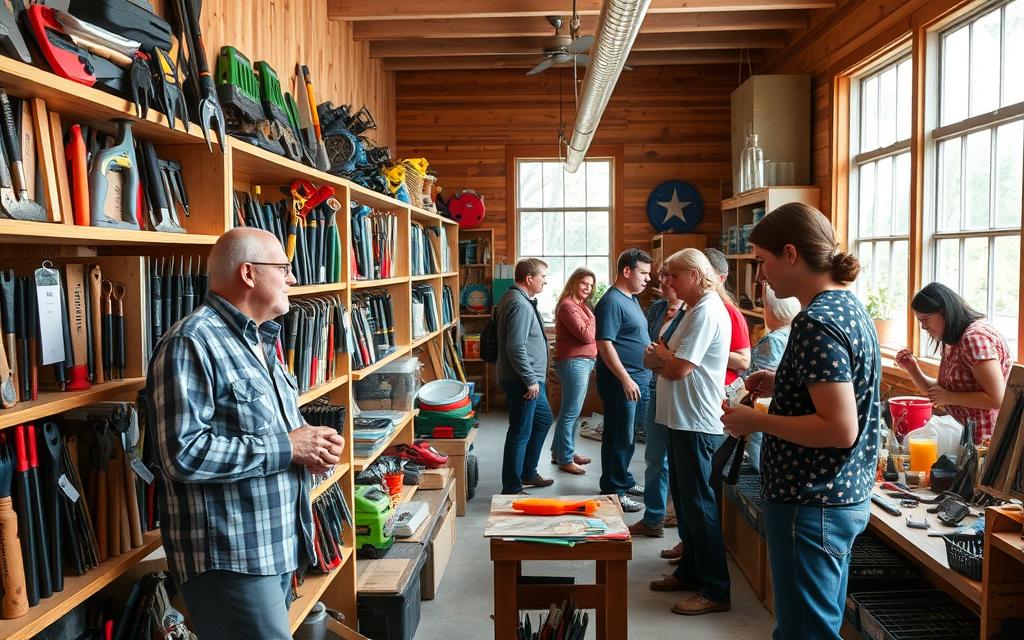Advertisement
Did you know the average power drill is used for only 12-13 minutes in its entire lifespan? This shows how tools are often not used to their full potential. Instead of buying tools that might only be used once or twice, people can borrow from a community tool library.
Borrowing tools can save money and reduce waste. It’s a greener and cheaper way to handle projects and repairs. Whether you love DIY or just need to fix things at home, using a community tool library can change the game.
What is a Community Tool Library?
A community tool library is a shared space where people can borrow tools for various tasks. It encourages community involvement and skill sharing. This way, people don’t need to buy tools for every project.

Definition and Purpose
A community tool library is like a tool lending program but instead of books, it lends tools. It’s not just about giving out tools. It’s about building a community, being green, and sharing skills.
These libraries have many tools, from gardening gear to construction tools. They help with home projects and community events.
How Tool Libraries Work
Tool libraries are easy to use and open to everyone. Here’s how they work:
- Joining is simple, and anyone can become a member.
- Members can look at tools online or in person and borrow them for a while.
- The time you can borrow tools varies, but it’s flexible for different projects.
- They also take care of the tools so they stay in good shape.
Knowing how tool libraries work helps see their value. They save money, help the environment, and bring people together.
Benefits of Using Tool Libraries
Tool libraries bring many benefits to both individuals and communities. They offer access to a wide range of tools without the need for personal ownership. This changes how people work on projects, share skills, and build community.
Cost Savings on Tools
One big advantage of tool libraries is the cost savings they offer. Members can borrow tools for specific projects, avoiding the need to buy tools that might only be used once. This is great for those who do DIY projects occasionally or for businesses needing specialized equipment for short periods.
For example, a homeowner might need a tile cutter for a single bathroom renovation. Instead of buying one that might sit unused, they can borrow it. This saves money and space.
| Tool | Purchase Cost | Rental/Borrowing Fee | Savings |
|---|---|---|---|
| Tile Cutter | $100 | $10 | $90 |
| Drill Press | $200 | $20 | $180 |
| Concrete Mixer | $300 | $30 | $270 |
Environmental Impact
Tool libraries also have a positive environmental impact. Sharing tools reduces the need for new tool manufacturing. This lowers the environmental footprint from production, packaging, and distribution. Tool libraries also encourage tool maintenance and repair, which extends tool life and reduces waste.
Community Engagement
Tool libraries also foster community engagement. They offer a place for members to meet, share skills, and work on projects together. This helps build stronger, more connected communities.
Many tool libraries also host workshops, classes, and events. These promote skill-sharing and community interaction. For example, a workshop on basic carpentry can teach new skills and help members meet others with similar interests.
Types of Tools Available
As a neighborhood resource center, community tool libraries have many tools for different needs. They make it easy for people to access tools they might not buy on their own. This way, everyone can find what they need for their projects.
Gardening Tools
Gardening is a favorite activity in many communities. Tool libraries have a wide range of gardening tools. From simple hand tools to specialized equipment, there’s something for everyone.
“Gardening brings people together, and having the right tools makes it even more enjoyable,” said a member of a local tool library.
- Trowels and shovels for planting
- Pruners and loppers for trimming
- Cultivators for soil preparation
Construction Equipment
For bigger projects, tool libraries have construction equipment. You’ll find drills, saws, and sanders, plus heavy-duty tools like cement mixers and generators. This lets members do projects they couldn’t afford before.
The availability of construction equipment is a game-changer for DIY enthusiasts and professionals alike. It saves money and reduces clutter from storing equipment.
Specialty Tools
Tool libraries also have specialty tools for specific tasks. You might find tile cutters, pipe wrenches, or other essential tools used less often.
“The variety of tools available at our local tool library has been instrumental in helping us complete our home renovation projects. We’ve saved money and learned new skills along the way.”
With a wide range of tools, community tool libraries are a key neighborhood resource center. They support many activities and projects in the community.
Who Can Use a Tool Library?
Community tool libraries welcome everyone. They promote sharing and teamwork. These libraries meet the needs of their communities.
Membership Requirements
Joining a tool library is easy. You just need to sign up and agree to the rules.
There’s no big hassle to join. Some libraries might ask for a small fee or a deposit. But these costs are low.
| Membership Benefits | Description |
|---|---|
| Access to a Wide Range of Tools | Members can borrow tools like gardening gear and construction equipment. |
| Cost Savings | Sharing tools saves money that would be spent on buying them all. |
| Community Engagement | Tool libraries bring people together, encouraging teamwork and support. |
Accessibility for All Community Members
Tool libraries aim to be open to everyone. They offer affordable memberships and tools for all needs.
Ensuring inclusivity is a main goal. Libraries provide services and tools for different needs.
How to Start a Community Tool Library
Starting a shared tool bank in your community is rewarding. It promotes cooperation and sustainability. By understanding your community’s needs and the steps to set it up, you can create a valuable resource for everyone.
Steps to Initiate a Tool Library
To start a community tool library, follow these essential steps:
- Assess community needs and gather support from local residents and organizations.
- Develop a clear mission statement and define the library’s goals.
- Secure a location for the library that is accessible to the community.
- Establish a system for managing tool inventory and circulation.
- Recruit volunteers to help manage the library and its operations.
Funding and Sponsorship Opportunities
Securing funding is crucial for a community tool library’s sustainability. Potential sources include:
| Funding Source | Description | Potential Benefits |
|---|---|---|
| Local Government Grants | Grants provided by local government to support community initiatives. | Financial support, potential for ongoing funding. |
| Corporate Sponsorships | Sponsorships from local businesses looking to support community projects. | Financial support, increased visibility for sponsors. |
| Community Fundraisers | Events organized by the community to raise funds for the tool library. | Raises funds, fosters community engagement. |
By exploring these funding options and following the steps to initiate a tool library, communities can successfully establish a shared tool bank. It serves as a valuable resource for its members.
Maintaining a Tool Library
Keeping a tool library running well depends on good maintenance. This includes managing inventory and keeping tools in top shape. When tools are well-maintained, members can use them easily, making the service better for everyone.
Tool libraries need to manage their tools well. This means keeping track of where tools are, if they’re available, and how they’re doing.
Tool Inventory Management
Managing tool inventory is key. It involves:
- Cataloging tools with detailed descriptions and categorization
- Implementing a checkout system that tracks tool usage and due dates
- Conducting regular inventory audits to identify missing or damaged tools
By following these steps, tool libraries can keep their tools ready for members. This makes the service more efficient and keeps members happy.
Cleaning and Repair Protocols
Keeping tools in good shape is also crucial. This means having rules for cleaning and fixing tools after they’re used. Regular care helps tools last longer and stay in better condition.
| Tool Type | Cleaning Protocol | Repair Protocol |
|---|---|---|
| Gardening Tools | Clean with soap and water, dry thoroughly | Sharpen blades, replace handles as needed |
| Construction Equipment | Wipe down with degreaser, inspect for damage | Repair or replace worn parts, lubricate moving parts |
| Specialty Tools | Follow manufacturer’s cleaning instructions | Refer to manufacturer’s repair guidelines or return to supplier |
By following these cleaning and repair rules, tool libraries can keep their tools working well. This helps the tool rental service succeed.
Success Stories from Around the U.S.
The community tool library movement is growing fast. Stories of its impact are coming from all over the country. These libraries are more than just places to borrow tools. They’re about making communities stronger and more sustainable.
Notable Tool Libraries
Many tool libraries across the U.S. are making a big difference. For example, the Seattle Tool Library in Washington is a leader. It offers a wide range of tools and equipment to its members.
The Berkeley Tool Library in California is also making waves. It promotes sustainability and community involvement through its programs.
Community Impact Testimonials
The real success of a community tool library is seen in its members’ stories. Jane Doe from Portland, Oregon, says the tool library changed her life. “I’ve been able to do projects I never thought possible,” she says. “And I’ve met amazing people.”
John Smith from Minneapolis, Minnesota, agrees. “The tool library has saved me money and connected me with like-minded people,” he says. “It’s a great resource for anyone wanting to make a difference.”
These stories show the power of community tool libraries. They foster a culture of sharing, sustainability, and community. As more success stories come in, it’s clear this model can help communities all over the country.
Tools of the Future: Modern Innovations
The future of community tool libraries is bright thanks to new tech. Tools are now more efficient, easy to get, and better for the planet.
Technology Integration in Lending
Technology is making borrowing tools easier. Digital inventory management systems help track what’s available. This makes it simpler for members to find what they need.
Some libraries use online booking systems. This lets members book tools ahead of time. It saves time and makes sure tools are ready when needed.
Sustainable Tool Development
Now, making tools is all about being green. Tools are made from sustainable materials and last longer. This cuts down on waste and the need to buy new tools all the time.
| Feature | Traditional Tools | Sustainable Tools |
|---|---|---|
| Materials | Often made from non-renewable resources | Made from recycled or sustainably sourced materials |
| Design | Designed for functionality, not longevity | Designed for durability and recyclability |
| End-of-Life | Frequently discarded, contributing to waste | Can be recycled or repurposed |
By choosing sustainable tools, libraries can help the environment. They encourage their members to be eco-friendly too.
Getting Involved in Your Local Tool Library
Joining a local tool library is a great way to help your community. It supports sustainability and sharing resources. By joining, you help build a culture of teamwork and caring for the environment.
Ways to Contribute
Volunteering is a key way to help. Tool libraries need people to keep things running smoothly. You can learn new skills and help out.
Organizing Events
Hosting events is another way to support your library. Workshops, tool demos, and fairs can spread the word. These events bring people together and strengthen your community.
Getting involved in your local tool library has many benefits. It helps your community and promotes green living and sharing.



